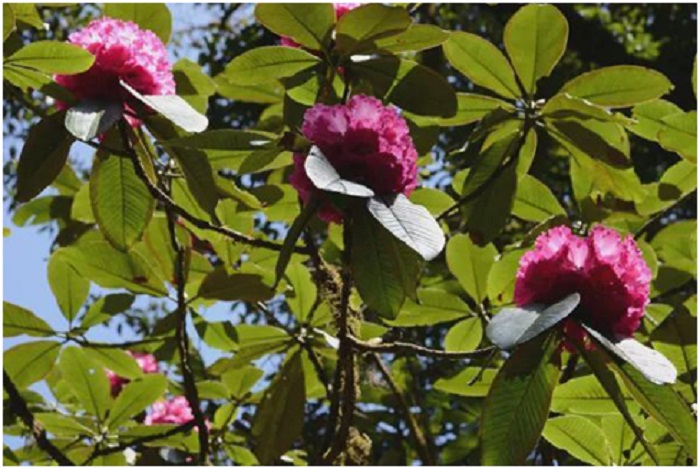



Gaoligong Mountain, sitting in the southwest of China, is home to about 17 percent of higher plants and 30 percent of mammals of the country.
It borders with the Qinghai-Tibet Plateau in the north and is listed as a key region of terrestrial biodiversity that bears international significance by Biodiversity Science, a journal run by the Biodiversity Committee under the Chinese Academy of Sciences (CAS).
Near a research and monitoring station in the Tengchong section of the Gaoligong Mountain, Yunnan province, seedlings of Rhododendron protistum var. giganteum, or big tree rhododendron, are planted under the woods.
The big tree rhododendron, also known as the “king of rhododendrons,” is one of the most typical plant species in the mountain. Due to its narrow geographic distribution and scarcity, the species had once been out of sight after its first discovery, which was by chance, in the early 20th century.
Duan Shaozhong, an official with the Baoshan management bureau of the Gaoligong Mountain National Natural Reserve, introduced that in order to get the exact number of the big tree rhododendrons, Chinese scientists started exploration tasks deep in the Gaoligong Mountain.
In the early 1980s, multiple big tree rhododendrons were discovered by a research team led by botanist Feng Guomei half way up the Gaoligong Mountain’s Tengchong section. The discovery significantly enhanced the confidence of Chinese scientists in further protecting the species.
In 1983, the government of Yunnan province approved the establishment of a provincial-level nature reserve in the Gaoligong mountain, and the nature reserve was made a national one upon a decision by the State Council three years later.
After systematic field research carried out by relevant government departments and scientists, the population of the big tree rhododendrons was confirmed to be 1,771 in 2014.
“It’s difficult for the seeds of the big tree rhododendrons, which are smaller than sesames, to sprout in primitive forests after they fall from the trees,” said Duan, explaining that the natural propagation is difficult as it has a rigid requirement in temperature, humidity, altitude, as well as other environmental conditions.
Therefore, artificial intervention is necessary. The CAS Kunming Institute of Botany and the Yunnan Academy of Forestry and Grassland have carried out artificial breeding and propagation experiments for the big tree rhododendrons, and the successfully bred seedlings are planted for further experiments in places that enjoy similar conditions with those in the plants’ natural habitats.
Linjiapu is one of the experiment bases. According to statistics, 200 seedlings were planted there in May this year, and they are currently growing well. Sixty percent of the first batch of seedlings planted in Linjiapu in 2017 survived, and the tallest of them have grown to 60 centimeters today, from 25 centimeters four years ago.
“The seedlings transplanted are mostly 25 centimeters, because they photosynthesize well at this height. It can be called a success that these plants have grown so tall over the past four years, as the big tree rhododendrons grow very slowly in natural environment,” Duan explained.
In 2005, Yunnan province proposed to protect species with extremely small populations, and approved a 10-year guideline in this regard five years later. A total of 62 plant species and 50 animal species were listed as the species with extremely small populations, and emergency measures have been taken to protect them.
Through on-site protection and artificial breeding, a series of endangered and critically endangered species have been conserved, including the big tree rhododendron and the Craigia yunnanensis.
Zhang Min is a forest ranger in the Gaoligong mountain who started protecting the woods eight years ago. “The government calls on us to protect the ecology, and the job offers stable income for us,” he said. According to him, when he just started working as a forest ranger, it was never an easy task to move in the mountain, and people were prohibited from entering it for half a year due to big snow. Fortunately, a tunnel was constructed in the mountain in April 2014, and made his patrols much easier, he said.
In a valley near the tunnel, Zhang set up the first infrared camera in the Dulongjiang section of the Gaoligong mountain. Apart from being forest rangers, Zhang and his fellows also grow Lanxangia tsaoko, a traditional Chinese herbal medicine, to gain extra income.
Head of Dulongjiang township Mu Xiaolong told People’s Daily that the township’s underwood planting is carried out in secondary forests, not natural forests, and forest rangers are on regular patrols to strictly observe the ecological red line.


The Executive and members of the.


The Acting Director, FCT Directorate of.


President Bola Ahmed Tinubu has been.



Barely a month after resignation of.


An Abuja based Legal Practitioner, Osuagwu.



Convener of Equitable Remedy, Mrs. Magaret.


Contractors handling the contract for city.


Nigerian government may have concluded plans.


The Diplomatic Correspondents Association of Nigeria.


A rights group, “Follow Me Talk.
Leave a Comment